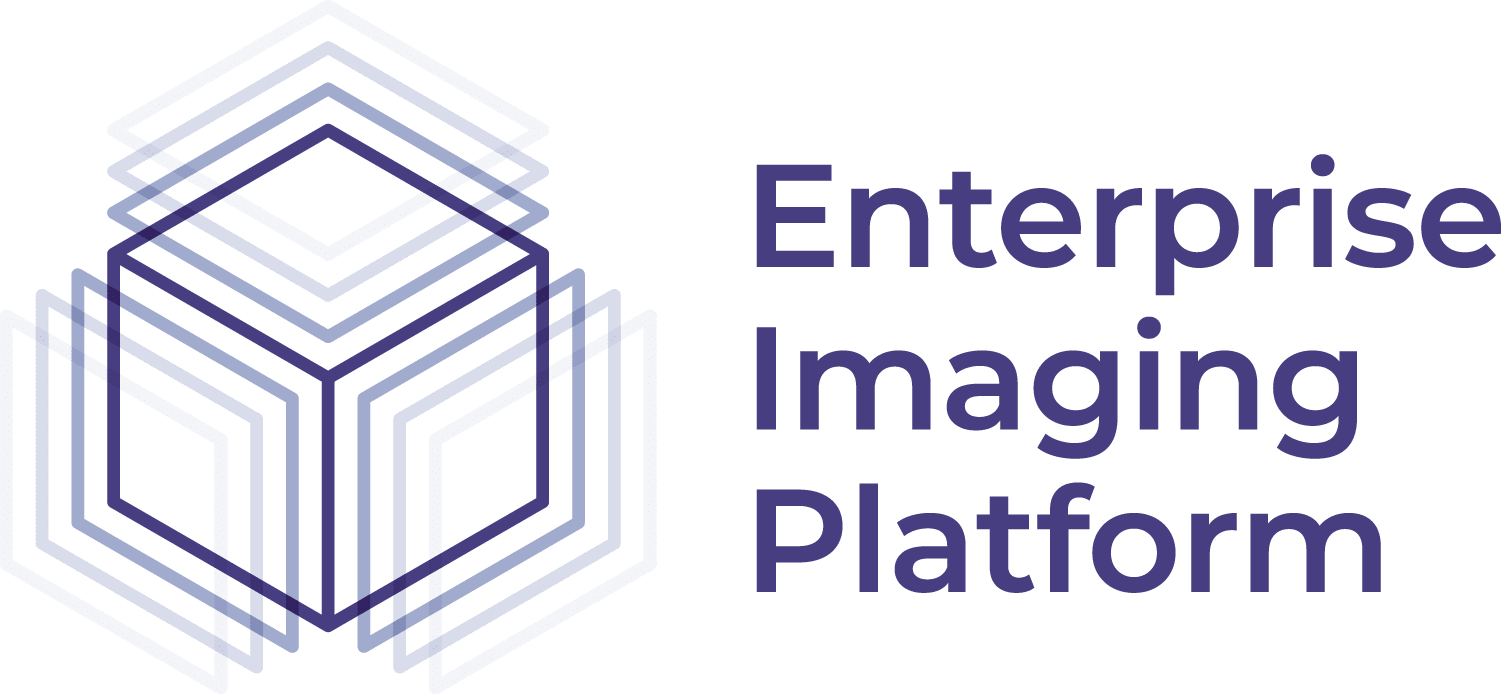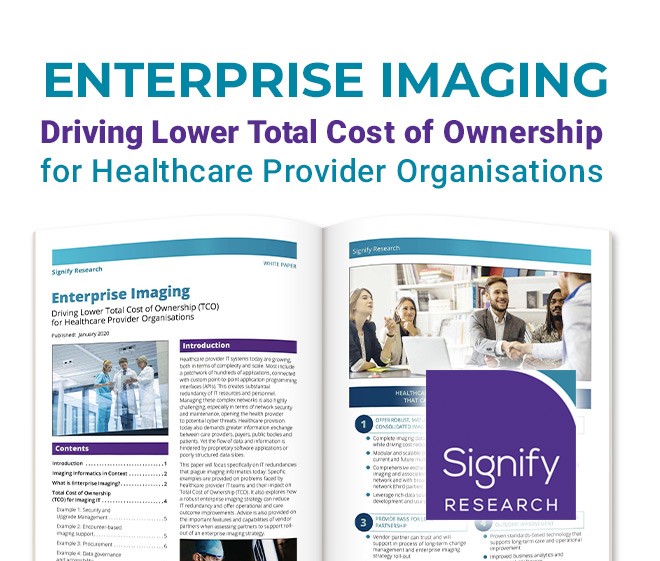5 Reasons why Health Systems
need to implement an Enterprise Imaging Platform

Dr. Anjum M. Ahmed
Chief Medical Officer
Agfa HealthCare
COVID-19 is now everywhere. Before I proceed any further, I want to take a moment to offer condolences to the families of those who may have lost their loved ones, wish strength to those who are currently fighting this disease and recovering, or avoiding it in self isolation, and express my admiration to those who are on the frontlines making sure the ones that are impacted are receiving appropriate care. As a former practicing physician, I can only imagine how this pandemic has been an overwhelming experience not only for healthcare staff, system administrators, but also the patients and their loved ones.
These are the longest weeks of my career when I have not traveled and met in person with our customers and thought leaders. My recent virtual meetings and conversations with industry partners, analysts and thought leaders at academic institutes and health authorities across the globe have signified the need to re-imagine the delivery of care, by focusing on “predicting” and “preventing”, with an emphasis on catching the disease before it strikes. There is growing need to aggregate clinical informatics, population profile, family and social history, wearable device informatics and pixel intelligence residing in diagnostic imaging.
This makes sense and emphasizes the need to intelligently consolidate predictive analytics, Artificial Intelligence (AI) and Machine Learning (ML) on a secure platform ecosystem.
However, before we embark upon discussing the outcomes-based application of innovative technologies in healthcare, let’s understand what COVID-19 has taught us so far, and how we could better prepare ourselves as we transition out to the “new normal”.
“COVID-19 has not only exposed the vulnerabilities in our healthcare system, its operations and infrastructure set up, but also the need for radical change how we deploy secure and modern platform ecosystems.”

1. The initial phase
While healthcare organizations across the globe have remained under pressure to deliver cost-effective and high-quality care, the COVID-19 challenge has exposed vulnerabilities in terms of how technology has created certain access and information silos.
The pandemic has also exposed the basic premise on which our health systems have been designed. This initial phase of lack of multispecialty data aggregation and systems interoperability posed significant diagnostic challenges.
While Coronavirus disease was eventually declared a pandemic on March 11, the impact on the diagnostic role of radiology was already being reimagined
2. The pandemic
As COVID-19 spread globally, there was growing interest relating to the role of diagnostic imaging, appropriateness of Chest X-rays and CT scans when it comes to screening, detection and follow up management.
While the appropriateness of Chest X-rays or CT scans to pinpoint COVID-19 pneumonia was being evaluated, a group of experts in Italy had been busy exploring the benefits of bedside ultrasound as one possible alternative for detection of COVID-19 pneumonia.
There were also initial reports that some technology startups were evaluating their machine learning algorithms, and developing new models, to detect COVID-19 specific findings leveraging Chest X-rays and CT scans.
The bottom line is that radiologists within the healthcare system and outside their enterprise were struggling to exchange useful imaging data with their international colleagues in their quest for collaborative learning and understanding of this new disease.
I have already discussed the role of radiology and AI in detail in a recent blog post.
3. The transition
I strongly believe that this phase of transitioning out to the “new normal”, or post pandemic, will provide critical lessons learned in relation to how health systems prepare themselves before returning to business as usual.
Radiology departments, while they have seen significant decline in certain diagnostic procedures due to the focus on COVID-19 related hospital visits, with the need to work remotely and in self isolation, have also mandated the need for secure and modular industrial scale Enterprise PACS solutions.
It was obvious that while COVID-19 was being evaluated from a diagnostic radiology perspective, COVID-19 related AI initiatives would pop up as well. While there have been few initiatives that are still works in progress, one thing’s for sure, the utility of AI within existing PACS systems will require workflow integration, and that’s where I see Agfa HealthCare standing out with its powerful rules-based workflow engine.
At Agfa HealthCare, because we had purposely built our Enterprise Imaging platform for modularity, we have seen several successes during this pandemic, at short notice, fulfilling requests of our customers ranging from at home workstation setups, image exchange and real-time collaboration to 100% remote supported GO LIVES.
4. The new normal
We do not know yet what the new normal would look like, however I think we do agree on the fact that COVID-19 has not only exposed the vulnerabilities in our healthcare system, its operations and infrastructure set up, but also the need for radical change how we deploy secure and modern platform ecosystems.
Clinicians were already overwhelmed with data, it’s now time to implement solutions that automate their workflows, improve productivity, provide analytical intelligence into outcomes measurement, and help offer optimized tasks that machines, and software are better programmed to do.
WHY ENTERPRISE IMAGING?
Agfa HealthCare’s Enterprise Imaging simplifies the access of a single comprehensive patient imaging record, empowers physicians and hospital management to make informed decisions through consolidation of multiple service lines within and outside the enterprise.
It is a comprehensive strategy that builds upon our standards-based platform and:
- Enhances care collaboration;
- Optimizes resources;
- Streamlines costs.

When it comes to diagnostic radiology or other specialty imaging, the path towards Enterprise Imaging has never been more meaningful then it is now, for following 5 main reasons:
1. Patient-centered view cross enterprise
An Enterprise Imaging solution should provide a universal view of patients’ multispecialty imaging timeline and journey. With COVID-19, patients may have been followed up over the duration of their care pathway with X-rays, or CT scans, and in some cases with portable devices like point of care ultrasounds.
- During this pandemic, in the UK, Agfa HealthCare was able to deploy its Enterprise Imaging XERO Exchange Technology to establish connected Radiology services across Yorkshire and the Humber. This modular technology will allow these organizations to view patient images and reports across seven NHS hospital trusts, as well as the newly established NHS Nightingale Hospital Yorkshire and the Humber. With demand on departments only increasing in response to the COVID-19 pandemic, this new technology enables the connected hospitals, which collectively cover a patient population of over 3 million, to diagnose patients who are transferred between sites at a much quicker rate than was previously possible. Patients will also benefit from this new technology as, in some cases, it will reduce the number of scans a patient needs, lowering the amount of radiation they receive, as well as the number of visits the patient needs to make to hospital.
- In the Netherlands, a nationally deployed COVID-19 portal solution has been introduced where we are supporting our customers in making DICOM images easily and efficiently available for other hospitals. This way, after triage, all the patient’s imaging information is shared securely with the receiving care team, so they can prepare to treat the patient quickly upon arrival.
2. Secure, multispecialty real-time communication and collaboration
Whether sharing imaging data within the enterprise or the need for collaboration with external expertise, the silos of imaging solutions have posed security, integration and interoperability challenges when it comes to multi-disciplinary team meetings. Because Agfa HealthCare builds its tools and applications on a modular platform ecosystem, our customers have enabled on a short notice, onsite and offsite image exchange and real-time chat and collaboration capabilities based on native tools available on the platform.
This allows our customers not only the privilege to share patients’ diagnostic imaging data in a secure environment between colleagues working in the hospital or at home, but also external expertise could be engaged when needed. The XERO Viewer, our zero-footprint diagnostic viewer, enables collaboration inside and outside the hospital as chat and communication tools let physicians and radiologists look at the same image while communicating securely in real time.
3. Faster reporting: remote, at home or on-premise
To deal with the COVID-19 outbreak, the continuity of the radiology reporting activities is crucial. To guarantee this, care providers are expanding the remote reporting capabilities for their radiology teams. In Ireland, one of our Clinical Application Specialists was approached by a Radiologist who was concerned about being able to work should the need to self-isolate arise. The hospital already had a VPN connection available as well as spare hardware, and within 20 minutes of assembling the spare clinical review workstation and a clinical monitor, the radiologist was able to log in, use his own profile from the hospital and report in his own home, including full speech recognition, with images instantly available over a normal broadband connection.
With new diseases comes new terminology. Since they are not standard in the Radiology lexicon, we received feedback from some radiologists their speech recognition software for fast reporting was struggling with the recognition of new terms like Corona or COVID-19. This was slowing down the reporting turnaround, since repeated manual correction of the not-recognized terms was needed. Our customers in Belgium and Luxembourg, using Enterprise Imaging integrated with the Nuance Speech Magic recognition software, have quickly re-trained their Nuance Speech Recognition systems and added those new terms to the speech lexicon.
4. Rules-based workflow, triage and task optimization
The power of Enterprise Imaging platform and modularity rests on its capabilities to adapt to varying demands of hospital systems that differ across the globe.
- For example, to support triage of high-risk patients, on request of a customer in the Middle East, we integrate an additional Question & Answer survey in the Agfa HealthCare RIS module. This questionnaire helps the receptionist to capture valuable triage information and to evaluate the risk of infection before the creation of the order and image acquisition. The risk information is communicated to the technologist’s work list who can take the necessary precautions and protection.
- To help the radiology team of a Belgian University Hospital, to keep track of the COVID-19 cases among other high importance cases, a dedicated COVID-19 worklist was created. From the Agfa HealthCare RIS, a COVID-19 indication is communicated to Enterprise Imaging, resulting in the creation of a COVID priority reading task. Task assignment rules enable these specific cases to be assigned to a specialized group of radiologists for reading, and escalation rules can also be employed to ensure quick response on highlighted cases.
5. Augmented intelligence: using data to better measure, predict and take action
- Optimizing radiology capacity in times of pandemic is key. With natively embedded analytical intelligence, as I discussed earlier, there’s more than ever need to move towards ‘predictive intelligence”. Catching first signs early can help stop the spread, and this is what our customers in Italy have done. With text search on radiology reports for term like ‘pneumonia’, ‘pneumonitis’, or any other relevant terms, they were able to retrospectively track the start of the outbreak.
- Agfa Healthcare’s Enterprise Imaging Business Intelligence (BI) module can help with daily real-time monitoring of the number of radiology exams allowing departments to better understand, plan or re-organize radiology services capacity for adequate workflow and response time in time of crisis. The BI module can be integrated with Google Maps to help visualize geographical information that can help local decision making in the fight against the virus spreading, e.g by visualizing infection clusters.
Our customers are already thinking ahead and exploring use cases to leverage our rules-based workflow engine, to practically implement image-based AI/ML algorithms not only for clinical use, but also to enable framework of collaboration leveraging our academic and teaching workflows.
The Road Ahead
At Agfa HealthCare, across the globe, we are not only responding to the unique requests of our customers and enabling COVID-19 specific configurations and workflows, but more recently, we have even helped one of the largest pediatrics health systems in the United States, to Go Live, 100% remotely supported. Among the unique challenges of the project were the escalating concerns regarding Coronavirus, which forced a change in approach as Children’s implemented a policy restricting on-site vendor engagement. As a testimony to their sense of ownership, confidence with the product, and the trust the project team cultivated through the customer-enablement implementation methodology, Children’s was adamant that the Go-Live proceed as a planned. And so, it did!
In conclusion, I once again wish everyone strength during these unprecedented times, wishing you the best of health, well-being and safety. At Agfa HealthCare, we will continue to work with our customers and thought leaders, listen to our respective governments, business partners and pool of talented colleagues, and offer the best of our innovation as a mark of respect to all those working to help deliver care during these challenging times.
Dr. Anjum M. Ahmed (MBBS, MBA, MIS, ITIL)
Global Chief Medical Officer
Agfa HealthCare




